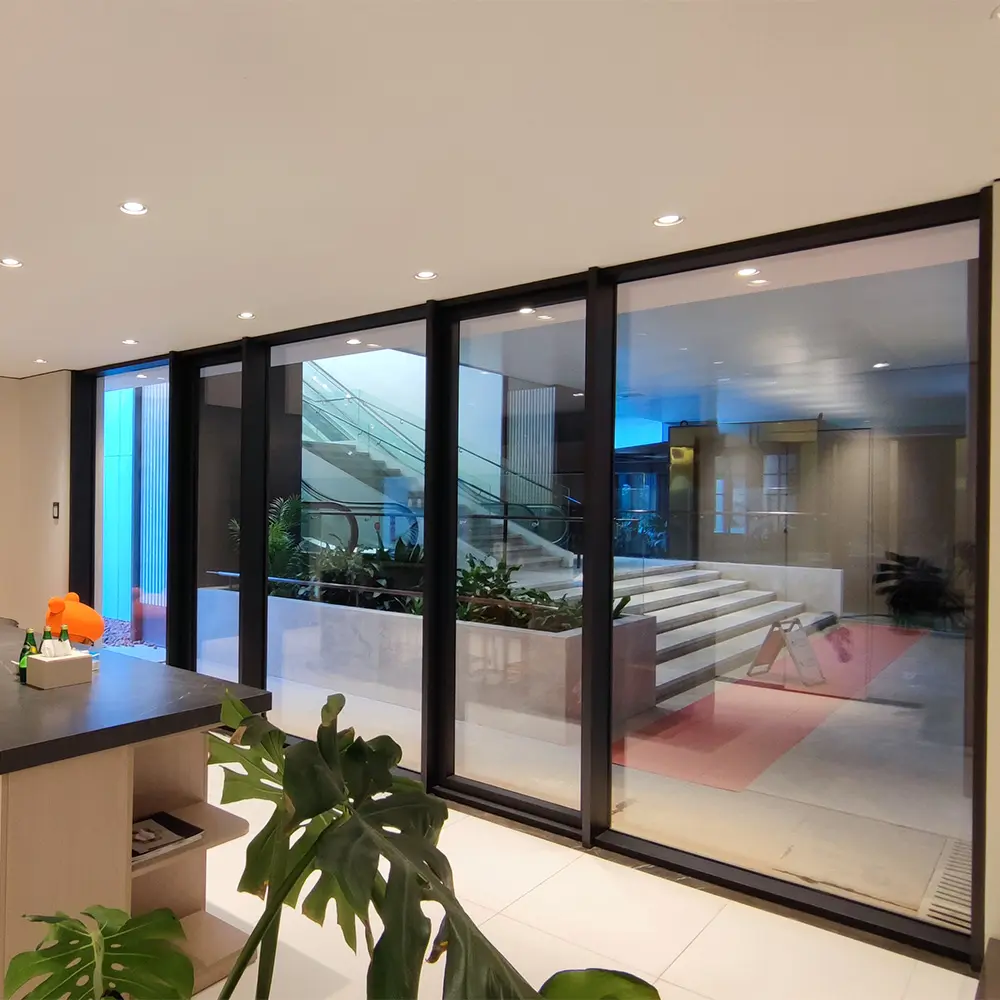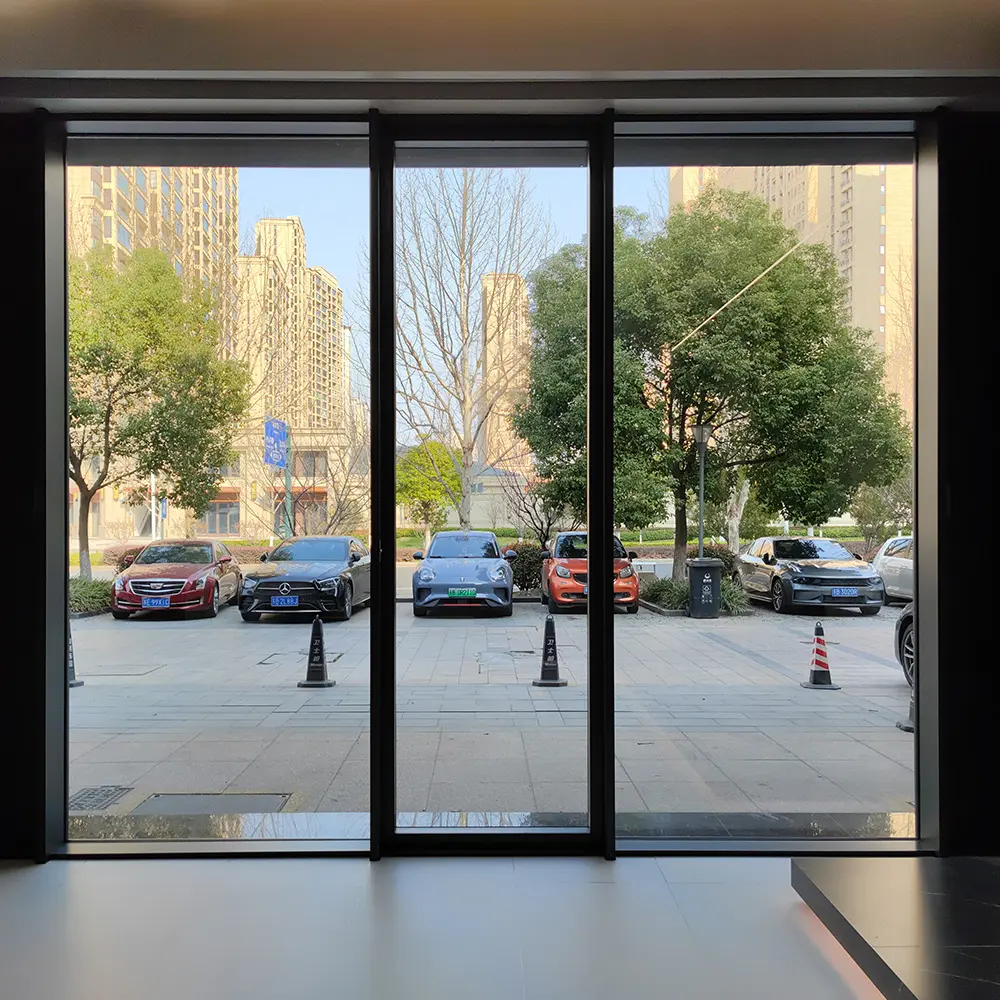פתרון חזית עכשווי לאופק עירוני
בעידן המודרני של האדריכלות העירונית, הדרישות הוויזואליות והפונקציונליות של בנייני גובה הן בעלות עלייה מהירה. אדריכלים וменפּים מחפשים דרכים חדשניות לבנות מבנים שמקיימים לא רק את תקנות הבנייה והיעדים האקולוגיים אלא גם מציעים מראה אסתטי בלתי מתחרה. אחד הפתרונות שעולה שוב ושוב למשורה הוא השימוש ב קירות ויטראז' . אלמנט עיצוב זה הפך למרכיב אופייני של גורדי שחקים מודרניים, ומביא שילוב של אלגנטיות, יעילות ודיוק הנדסי. ככל שהתמונות הערים מתקדמות, קירות הוויטראז' ממלאים תפקיד מרכזי בהגדרת המראה והביצועים של מבנים עכשוויים
החשיבות הארכיטקטונית של קירות ויטראז'
שינוי האסתטיקה עירונית
קירות ויטראז' מביאים רמת שקיפות וקלות לבניינים גבוהים שלא ניתן להשיג במערכות קירות מסורתיות. המראה החלקלק והמינימליסטי שלהם תורם לתמונה עירונית עתידנית, תוך מתן תצפית בלתי מופסקת מפנים המבנה. הקירות משקפים את הסביבה, ומאפשרים למבנים גבוהים לשלב בצורה הרמונית עם קו השמיים. קירות ויטראז' מביעים הצהרה ארכיטקטונית חזקה, תוך שמירה על עקביות ויזואלית עם הסביבה
העצמת גמישות בעיצוב
מאפיין אחד המוערך ביותר בקיר הווילון הזכוכיתי הוא חופש העיצוב שהוא מציע. אדריכלים יכולים לערוך ניסויים עם צורות, זוויות וצורות שלא היו אפשריות או לא מעשיות עם חומרי בנייה מוסכמים. תכונת הלא התומכת במשקל של קירות וילון זכוכיתיים מאפשרת להקצות שטח גדול יותר לזכוכית, ומאפשרת יצירתיות בפצרים והיכולת להתאים את פני החיצון של הבניין לחזון של הלקוח.

ביצועים ויעילות אנרגטית
אופטימיזציה של אור טבעי
האפקט של האור הטבעי הוא עדיפות במבנה של בניינים גבוהים, וקיר וילון זכוכיתי מצטיין בתחום זה. בעזרת חדירת האור פנימה, מערכות אלו מפחיתות את הדרישה לתאורה מלאכותית ותורמות לרווחת התושבים. קירות וילון זכוכיתיים הממוקמים בצורה אסטרטגית יכולים אפילו לעזור ברגולציה של הרגעי היקפיים ולתמוך ביעילות בסביבות מסחריות או מגורות.
שיפור ביצועי החום
טכנולוגיות זכוכית מתקדמות המשמשות בקירויי זכוכית מודרניים מציעות יכולות בידוד גבוהות. יחידות זכוכית כפולה או משולשת עם מיסוך מינון-E, מילוי גז ושבירה תרמית עוזרות למזער העברת חום, ובכך מפחיתות את עלות החימום והקירור. בשילוב עם טכניקות שליטה סולארית חכמות, קירות אלו מעצימות את הביצועים האנרגטיים של מעטפת הבניין.
הטבות מבניות ודقة הנדסית
ניהול עומס רוח
בניינים גבוהים חייבים לעמוד בעומסים ניכרים של רוח, וקירויי הזכוכית מותאמים לחלק עומסים אלו בצורה יעילה. באמצעות מערכות עיגון, עמודי תומך ומבנים משניים, הם מספקים תמיכה מבנית נדרשת תוך שמירה על פרופיל קליל. פתרונות הנדסיים אלו מאפשרים לקירויי זכוכית לפעול באופן מהימן בתנאי מזג אוויר קיצוניים מבלי לפגוע בשלמות הפקד.
עמידות בפני אלמנטים סביבתיים
חומות קירור זכוכיתיות נועדו להתנגד לחדירת אוויר ומים באמצעות מספר מערכות חותמות, תאי איזון לחץ ונתיבי ניקוז. תכונות אלו הופכות אותן לאפקטיביות גבוה בשמירה על סביבה פנימית מבוקרת גם באזורי אקלים קשים. בנוסף, החומרים המורכבים בחומות קירור זכוכיתיות הם לרוב בעלי עמידות בפני קורוזיה, מה שמבטיח תפקוד לטווח ארוך.
תוקפנות ו אחריות סביבתית
תרומה לאישורי ירוק
מבנים שמצוידים בחומות קירור זכוכיתיות נוטים להשיג ציונים גבוהים במערכות דירוג של מבנים ירוקים כמו LEED ו-BREEAM. היכולת exploited אור יום, הפחתת הדרישה לתאורה מלאכותית והשכלת יעילות מיזוג אוורור ותחמוצת, תורמות לאופטימיזציה של צריכת האנרגיה. יתרונות אלו עוזרים למפתחים לעמוד במטרות של קיימות ולקטין את פוטבול הפחמן הכולל של מבנה.
שימוש בחומרים שניתנים להחזרה וברורים לסביבה
קירות занית זכוכית נפוצים מיוצרים מחלקים שניתנים tái עיבוד כמו אלומיניום וזכוכית. יצרנים רבים גם כן משתמשים בשיטות ייצור ידידותיות לסביבה, ומסוות את המוצר עם עקרונות עיצוב בר קיימא. אורך החיים הארוך ודרישות התחזוקה המזעריות מעצימות את הערך הסביבתי של קירות זכוכית занית.
נוחות אקוסטית ובصرית
הabilidade להפחית קול
בסביבות עירוניות צפופות, בידוד קול הוא שיקול חשוב. קירות זכוכית занית מודרניים משתמשים בזجاج מקשה, שכבות בידוד קול וביחידות זכוכית מבודדות כדי למזער את חדירת הרעש החיצוני. זה הופך את הפנים של מבנים גבוהים לשקטים יותר ומעודדים יותר להפקדה, מנוחה ומנוחת נפש.
בהירות בصرית ונוחות פנימית
זכוכית בעלת ביצועים גבוהים המשמשת בקיר занנים מספקת נראות מצוינת ללא הפגם של הבזק שמש או התחממות. מיסבים מתקדמים וצבעים מספקים מעבר סלקטיבי של אור, המשלבים בין בהירות לנוחות. כתוצאה מכך, קירות זכוכית занנים משפרים את חוויית המשתמש במבנים גבוהים על ידי ודיג נוחות ויזואלית ותרמית.
תחזוקה נמוכה וארוך חיים
ทนทาน של חומרים
קירות זכוכית занנים מותאמים לשרידות של עשרות שנים ללא ירידה משמעותית ב характеристик. החומרים משמשים עמידים בפני קרינת UV, קיצוני טמפרטורה ו מזהמים. בהתקנה ותפעול תקינים, מערכות אלו שומרות על שלמות מבנית וויזואלית לאורך חיי הבניין.
ניקוי ותיקונים מפושטים
רבות ממערכות קיר הזכוכיתienen תוכננו להנגשת קלה, מה שעושה את התחזוקה והניקוי הרגילים יעילות יותר. חלק מהמבנים כוללים אף מערכות אוטומטיות לניקוי חלונות. החלפת יחידות זכוכית או מסגרות בודדות היא פשוטה, ומקטינה הפרעות תפעוליות לאורך זמן.
בטיחות ונימוס
תקני עמידות באש
בבניות מרובעיות בולטות ביטחון הוא בעדיפות ראשונה, וקירות занף זכוכיתיות פותחו בהתאם לתקני הבטחה באש קפדניים. קיימות אפשרויות זכוכית עם דירוג אש, וتقنيות קומפרטמנטיזציה מבטיחות שהקיר занף לא יאיץ את התפשטות האש בין הקומות.
הגנה סיסמית ונגד מכה
באזורים סיסמיים או באזורים הנוטים לאירועי מזג אוויר קיצוניים, נבדקו קירות הזجاج הקדמים ל regarding ולחידוש. הם נבנו כדי לספוג תנועה ולסובב אנרגיה, וכך להפחית את הסיכון לכשל מבני. מערכות מסגרת ותפסים מחוזקות מעצימות את תכונות ההגנה שלהן מבלי להתפשר על שקיפות או על אסתטיקה של העיצוב.
התאמה להתקדמות טכנולוגית
תיכנות עם מערכות בניין חכמות
קירות cortina זוכים לשילוב מוגזם בטכנולוגיות בניין חכמות. ניתן לשלב בהם חיישנים, התקני צילוי אוטומטיים וזجاجים ריאקטיביים כדי להתאים את הסביבה בזמן אמת. תכונות אלו מאפשרות לבניין לנהל באופן פעיל את צריכה האנרגטית ואת הנוחות של התושבים.
תאימות עם מערכות אנרגיה מתחדשת
זכוכית פוטוולטאית ופאנלים סולריים יכולים להיות מוטמעים בקירות cortina, ולהפוך את מעטפת הבניין למקור ייצור אנרגיה פעיל. שילוב חלק זה תומך במטרות האנרגיה השוויונית ומעודד את הרמת הפרויקט הטכנולוגי של מבנים גבוהים.
מפתה שוק וערך נדלן
שיעורי שכירות ותפוסה מוגזמים
בניינים עם קירות занית מושכים בדרך כלל יותר שוכרים, בזכות המראה המודרני וחווית המשתמשים המוגדלת. האור הטבעי, הנוף הפתוח והנוחות התרמית הופכים את המרחב הזה לרצוי יותר. כתוצאה מכך, מבנים גבוהים עם קירות занית דורשים דמי שכירות גבוהים יותר ומלאים מהר יותר.
ערך נכס ארוך טווח
השילוב של עלויות תחזוקה נמוכות, יעילות אנרגטית ומראה אסתטי מבטיח כי מבנים עם קירות занף י conservו ערך שוק גבוה יותר לאורך זמן. משקיעים וменuftים מזהים את היתרונות האסטרטגיים של מערכות אלו, במיוחד בשווקי נדל"ן עירוניים תחרותיים.
פרספקטיבות עתידיות על קירות занף
אבולוציה במדעי החומרים
במידה שמדעי החומרים ממשיכים להתקדם, נוכל לצפות כי קירות занף יהפכו להיות יעילים ומרובדיים אף יותר. חדשנות בזجاج דינמי, מצעים אוטו-ניקוי ותבניות סופר דקיקות תמשיך להגדיר מחדש את הגבולות האפשריים בעיצוב פאסייטים של בניינים גבוהים.
טנדים של קבלת עולמית
בעולם כולו, אדריכלים וменuftים מקדמים בהדרגה את השימוש בקירות занף. מאסיה ועד צפון אמריקה, מערכות אלו הופכות לסטנדרט בבנייה של מבנים גבוהים, בזכות היתרונות הבלתי מתחרים שלהן גם בביצוע וגם בעיצוב. הפופולריות העולמית שלהן היא עדות לVERSATILITY ולערך הנצחי שלהן.
שאלות נפוצות
מהי קיר זכוכית במבנה בנייה?
קיר זכוכית הוא מערכת קירות חיצוניים שאינה נושאת, ש chế לה מזכוכית ומתכת, שתוכננה כדי לעמוד באלמנטים סביבתיים תוך כדי סיפוק יתרונות אסתטיים ופונקציונליים.
האם קירות זכוכית משפרים את היעילות האנרגטית?
כן, קירות זכוכית מודרניים משתמשים בזجاج ביצועי גבוה ובטכנולוגיות בידוד כדי למזער את האובדן האנרגטי ולצמצם את הנסמך על תאורה מלאכותית ועל מערכות קירור וחימום (HVAC).
האם קירות זכוכית מתאימים לכל האקלימים?
קירות זכוכית תוכננו כך שיבצעו היטב במבחר של אקלימים, תוך שימוש בפתרונות זجاج מותאמים אישית, שבתים תרמיים ומערכות הרמה כדי להתמודד עם תנאי הטמפרטורה והطقס.
כמה זמן קירות זכוכית נמשכים בדרך כלל?
כאשר קירות הזכוכית מותאמים, מותקנים ומשומרים כראוי, הם יכולים להימשך עשרות שנים עם ירידה מינימלית בביצועים או במראה החיצוני.

